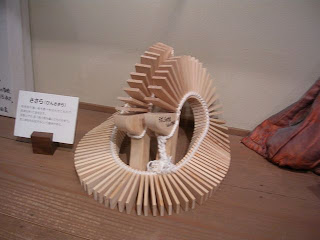August 15 and 16, 2008
From Takayama, we caught a bus to Ogimachi.
There was a ton of traffic, so the bus was moving slowly. This is Julian's "mow" face. When a Japanese person becomes frustrated or upset, you will often hear a disgruntled and sometimes extended "moooooooooooowwwww".
 There are some villages in Shirakawago and Gokayama that showcase old, traditional, A-frame style farmhouses called gassho-zukuri (hands in prayer). The houses were built this way to protect them from heavy snowfall.
There are some villages in Shirakawago and Gokayama that showcase old, traditional, A-frame style farmhouses called gassho-zukuri (hands in prayer). The houses were built this way to protect them from heavy snowfall.In the 1960's, Construction of a dam threatened to eventually submerge these houses. The government intervened and moved many of these houses to preserve them. In 1995, some of these villages became Unesco World Heritage sites.
Our first stop was the village of Ogimachi which has the largest collection of gassho-zukuri. We didn’t have much time, because we needed to catch a bus to another smaller village. Below are a few snapshots before we moved onto the next place.
Ainokura is a smaller village that has 15-20 gassho-zukuri. These houses are about 2 or 300 years old. I booked a room in one of the houses. Ainokura is stunning!
As soon as we arrived, we hiked around the area up a small mountain and took lots of pictures. We saw many juicy grass hoppers, which made me hungry!
 We stayed at Yomoshiro Guesthouse, which is in the Lonely Planet travel guide. I couldn't find anything on the internet about this excellent place, so the phone number is 076-366-2377. The guest house was great! Noriko prepared wonderful meals for us, including sashimi, Iwana (a small river fish), tempura and local mountain vegetables. We ate with a French family and a big Japanese family too. It was full that night, so we slept upstairs, which was great! We had the floor to ourselves, and when it rained that night, there was a cool breeze.
We stayed at Yomoshiro Guesthouse, which is in the Lonely Planet travel guide. I couldn't find anything on the internet about this excellent place, so the phone number is 076-366-2377. The guest house was great! Noriko prepared wonderful meals for us, including sashimi, Iwana (a small river fish), tempura and local mountain vegetables. We ate with a French family and a big Japanese family too. It was full that night, so we slept upstairs, which was great! We had the floor to ourselves, and when it rained that night, there was a cool breeze.
The next day, as we were hiking around the village, we came across this storehouse filled with susuki grass, which is native to that area and used for the roofs. It costs about 2 or 300, 000 dollars to replace a roof. It has to be replaced every 30-40 years. Many of these houses were in disrepair until the government stepped in with grants covering around 95% of the cost. It takes a team of 200 people to re-thatch one side of a roof in two days time.


And of course there is concern for fire. Scattered around the village are these fire hydrants, that shoot upwards to put out roof fires.
It takes a bit of time to get to this region of Japan, but it's well worth the visit. That afternoon we took a bus from Ainokura to our final vacation destination of Kanazawa.













No comments:
Post a Comment